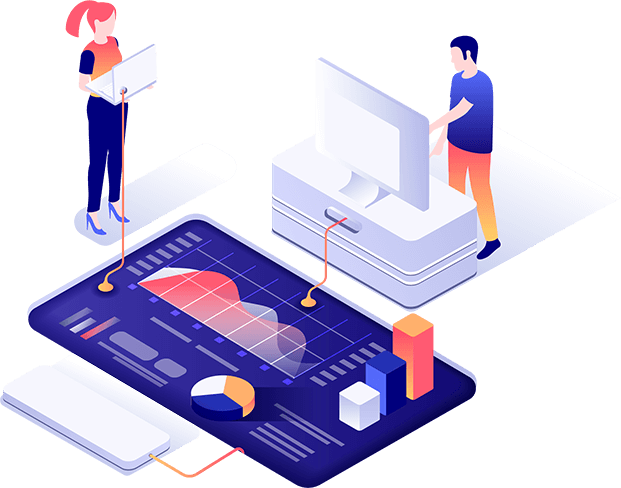DIGITAL
Website Design

Top Trends of website design
The Importance of Web Design
Website designing plays an important role in every business to make it a successful one. A good web design, or a variety of unique website designs, may bring the right target audience to your site. It’s like wearing that fancy suit at a job interview-you want to impress the visitors from the very first click. A well-planned web page improves search engine visibility.
Web crawlers just love structured layouts and relevant content, constant user interface design-they gobble it up and give you higher rankings in return. With modern technology, loading and response are very fast. Your brand will look much more believable in their eyes if users find easy navigation and useful features.
A web designer who loves creative solutions can make your site stand out. Imagine giving your website a charming personality. The right design process leads to better user experience. This approach sets the stage for true business growth.
Responsive Web Design Trends
Keeping abreast of current web page design can sometimes be as difficult as trying to flag down an ice cream truck that’s rumbling down the road: ideas are moving fast, and you need top design options to keep up. Modern website designs are essential to stay competitive and attract users.
Responsive design ensures that your site pops on mobile devices. Users like to view things on their phones without putting too much strain on their eyes. Web designers usually employ graphic designers to put a little style into things. But it is not all glitz and glamour pictures. Today, simplicity and clarity are also stressed as trends, so there are no distractions and more focus on the user interface.
Experienced designers understand how to mix style with usability, aiming for high performance so each page loads fast. Nobody likes a site that takes a lifetime to open. The key word in effective web design is balance: a balance between aesthetics, features, and function.
Enhancing User Experience with User Interface Design
User experience, or UX design, is essential to your website presence and is greatly influenced by the quality of your website designs. Guests depart if a website is dull or confusing. It’s the same as presenting someone with a defective umbrella during a rain shower. You should create pages to assist users in achieving their desired objectives.
Wireframes, mockups, and prototypes can enhance your structure. Think about what the target needs in the beginning. That encompasses their reading patterns, browsing tendencies, and devices. A well-designed user interface is crucial for clarity and comfort. UI design principles keep everything structured and intuitive.
A friendly brand is a trusted brand. This strategy creates greater user experience, greater engagement, and greater conversions. An audience will always love a site that acts like a good host.
E-commerce Web Design Strategies
For online shopping, website designs are not merely pretty images or bright colors. It is about leading individuals to buy your products or services. If you are selling sock puppets as a business, you want individuals to buy them without ambiguity.
A well-designed site uses a clean user interface design to display product information. Good graphics and images present each product at its best viewing angle. Web crawlers adore well-labeled products and apt keywords, for this truly enhances search engine rankings. It should have means of payments at their fingertips and truly should not be a hassle with the checkout. Just roll out the red carpet for your clients, sliding them smoothly from the shopping cart into your bank account.
It also should be a secure environment in which trust can be built in your site-making users feel comfortable sharing personal information. That is the secret to e-commerce success.
Industry-Specific Web Design
Different industries call for different web approaches. A healthcare site might require rigorous privacy measures. A finance company might want to present bedeviling data in neat charts, while unique website designs cater to specific industry needs. In the design process, unique regulations and user needs both come into play.
It’s like baking cupcakes for a gluten-free friend. You adjust your ingredients for best results. Seasoned designers know how to tailor websites to the particular field in which they exist. That means fresh ideas, a relevant brand voice, and specialized features. Some industries love bold animation or striking graphics, while others lean toward a simple layout.
The goal remains the same: better user experience. People in every market want easy navigation, quick access to information, and a consistent interface. When designs created align with industry standards, you earn credibility and trust.
Choosing the Right Web Designer
Choosing the right web designer is like finding the perfect dance partner for your business. You need someone who can keep up with your rhythm and make you look good on the digital dance floor. Here are some key factors to consider when selecting a web designer:
- Experience and Portfolio: Look for a web designer with a strong portfolio that showcases their experience in creating websites for businesses similar to yours. Check their portfolio for examples of responsive web design, user interface design, and interactive elements. A seasoned designer will have a diverse range of projects that demonstrate their ability to adapt to different industries and styles.
- Expertise in Programming Languages: Ensure the web designer is proficient in programming languages such as HTML, CSS, and JavaScript. They should also be familiar with content management systems (CMS) like WordPress or Joomla. This technical know-how ensures they can build a robust and flexible site that meets your needs.
- Understanding of Web Accessibility: A good web designer should have knowledge of web accessibility guidelines and be able to create websites that are accessible to people with disabilities. This not only broadens your audience but also shows that your brand cares about inclusivity.
- User Interface (UI) Design Skills: A well-designed user interface is essential for a positive user experience. Look for a web designer with expertise in UI design and a portfolio that showcases their skills. A great UI design makes navigation intuitive and enjoyable, keeping visitors on your site longer.
- Search Engine Optimization (SEO) Knowledge: A web designer should have a basic understanding of SEO principles and be able to create websites that are optimized for search engines. This ensures your site ranks well and attracts organic traffic.
- Communication and Project Management: Good communication and project management skills are essential for a successful web design project. Look for a web designer who is responsive, organized, and able to manage your project effectively. Clear communication helps avoid misunderstandings and keeps the project on track.
By considering these factors, you can find a web designer who will create a website that not only looks great but also performs well and meets your business goals.
Creating Effective Web Pages
Creating effective web pages is like crafting a compelling story—you need to capture your audience’s attention and keep them engaged from start to finish. Here are some key factors to consider when creating web pages:
- Clear and Concise Content: Web content should be clear, concise, and easy to read. Use headings, subheadings, and bullet points to make your content scannable. This helps site visitors quickly find the information they need without getting overwhelmed.
- Responsive Web Design: Ensure your web pages are optimized for mobile devices and tablets. A responsive web design will adapt to different screen sizes and devices, providing a seamless experience for users on the go. With more people browsing on their phones, this is non-negotiable.
- User-Friendly Navigation: A user-friendly navigation system is essential for helping site visitors find what they’re looking for. Use clear and concise labels and avoid clutter. Think of it as a well-organized library where every book is easy to find.
- Interactive Elements: Interactive elements such as buttons, forms, and animations can enhance the user experience. Use them sparingly and ensure they are accessible to people with disabilities. These elements should add value, not distract from the main content.
- Search Engine Optimization (SEO): Optimize your web pages for search engines by using relevant keywords, meta tags, and descriptions. This helps improve your visibility on search engines and drives organic traffic to your site.
- Web Accessibility: Ensure your web pages are accessible to people with disabilities by following web accessibility guidelines. This includes using alt text for images, providing keyboard navigation, and ensuring color contrast. Accessibility is not just a legal requirement; it’s a moral one.
- Graphic Design: Use high-quality graphics and images to enhance the visual appeal of your web pages. Ensure they are optimized for web use and don’t slow down page loading times. Good graphic design can make your content more engaging and memorable.
- Testing and Iteration: Test your web pages regularly and iterate on the design and content based on user feedback and analytics data. This helps you identify and fix issues, improving the overall user experience.
By considering these factors, you can create effective web pages that engage your target audience and achieve your business goals. Remember, a well-designed web page is like a good book—it keeps readers coming back for more.
Web Design Packages and Pricing
Web design packages can range from candy options in the sweet shop: some with custom layouts, advanced graphics, and robust marketing support, while others will have simple website designs created for tight budgets. It’s all about knowing your needs.
Is it a startup that needs only a basic page, or are you a bigger company thats looking full e-commerce platform? Depending on how complex and feature-rich one is, this is where it changes in price. Additional functionality might be SEO plugins, analytics dashboards, or integrated social media. And that always leaves subsequent care: it may be desirable to make further updates or adjust the brand later on.
Clear designers will outline prices, timelines, and expected outcomes. This helps avoid nasty surprises. A great website design usually pays in returns.
Launching and Maintaining Your Web Design
Launching a new website is like releasing doves at a wedding: everything looks real graceful, but you’re secretly hoping those birds aren’t going to ruin your suit. Test your site before it goes live. Make sure the images load right, the forms work, and every link goes to the right page.
Check that your responsive design holds up on mobile. Web crawlers like a clear path, so fix those broken links. Finally, after launch, follow the user experience and search performance continuously. Update the content, refresh graphics, and know where technology and/or design is taking new steps.
Maintenance will ensure real success: if your site is fresh, they will continue to come back. A good, well-cared-for online presence pays back many times into your brand equity and outlook on business.
Conclusion
Your website design journey doesn’t end after it launches but instead is just getting started, with continuous improvements to your website designs. Keeping the visitor happy with the emphasis on user interface design, responsiveness, and straightforward layout helps keep the brand alive. Make sure to keep your target audience entertained through creative content, considerate navigation, and rapid page loading.
Web crawlers like fresh updates, too, so don’t be stingy with the SEO strategies. E-commerce sites are benefited with secure payment gateways and attractive product display. Above all, ensure good user experience and keep improvising each webpage. You will be able to develop a high-performance platform that delights users and propels your business forward if you adopt the right approach
Current Clients
Organic Views
Brands we Work with









Blog
Latest News
esse nusquam. Eam iriure diceret oporteat.






Importance of Website Design
Good website design enhances user experience, boosts credibility, improves SEO, and increases conversions by providing intuitive navigation, appealing visuals, and responsive functionality across all devices.
.01
Key Elements of Website Design
Website design includes layout, typography, color schemes, images, and navigation, all working together to create a visually pleasing, user-friendly interface that encourages engagement and interaction.
.02
Responsive Website Design
Responsive design ensures websites adapt to various devices and screen sizes, providing seamless user experiences, faster loading times, and improved SEO performance for better accessibility and reach.
.03